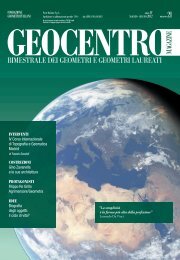Geocentro Magazine - Fondazione Geometri
Geocentro Magazine - Fondazione Geometri
Geocentro Magazine - Fondazione Geometri
You also want an ePaper? Increase the reach of your titles
YUMPU automatically turns print PDFs into web optimized ePapers that Google loves.
Ai vari trattati di geometria pratica, sorti nei precedenti<br />
decenni sulla scia della tradizione euclidea, si aggiunge<br />
già sul finire del Quattrocento un nuovo genere di<br />
opere, dedicato alla cosiddetta arte militare. Sulle orme<br />
del vecchio trattato di Roberto Valturio, dal titolo De re<br />
militari del 1472, che per primo raccoglie una descrizione<br />
delle tecniche e degli strumenti di rilevamento ereditate<br />
dalla tradizione medievale come bagaglio indispensabile<br />
dell’uomo d’arma, nuovi sforzi si compiono da parte di<br />
illustri matematici come Niccolò Fontana, maggiormente<br />
noto come il Tartaglia, per il perfezionamento delle<br />
pratiche topografiche in campo militare.<br />
È quindi in funzione delle specifiche esigenze dell’artiglieria<br />
che la carta geometrica comincia a dare risposte concrete<br />
ai bisogni militari, consentendo di progettare opere di<br />
fortificazione, bastioni, gallerie, trincee, diversivi, falsi scopi.<br />
Non mancano poi in questo quadro sofisticati apparati<br />
di “spionaggio topografico”, come il singolarissimo<br />
distanziometro di Baldassarre Lanci, strumento ideato nel<br />
1557 per rilevare il territorio con soli procedimenti grafici,<br />
senza cioè l’esecuzione di calcoli, e per ricavare la pianta di<br />
una fortezza da lontano, senza essere visti dal nemico.<br />
Mentre alla scala urbana è principalmente ai topografi<br />
rinascimentali che si deve dunque il merito di aver<br />
codificato le regole per la realizzazione delle nuove carte<br />
geometriche e di aver dettato i principi per la costruzione di<br />
nuovi strumenti, con rare eccezioni come nel caso di Marco<br />
Antonio Pasi e di Cristoforo Sorte, alla scala territoriale,<br />
Therefore, we have to credit to the Renaissance topographers<br />
the creation of a code for the realisation of new geometric maps<br />
and the definition of the rules for the manufacturing of new<br />
instruments. With the exception of Marco Antonio Pasi and<br />
Cristoforo Sorte, the understanding of the Ptolemaic lesson<br />
(how to draw a spherical surface on a plane, still maintaining<br />
the abovementioned “proportio cuiusque partis ad universale”)<br />
has to be credited to astronomers and mathematicians.<br />
In Italy, the XVI century ends with important cartographical<br />
documents, both in chorography and topography, masterpieces<br />
of famous artists, such as Egnazio Danti (1536-1586) and<br />
Giovanni Antonio Magini (1555-1617). This latter put an<br />
end to the era of pre-geodetic cartography and drew the first<br />
homogeneous map of Italy in 61 sheets. This map was elaborated<br />
thanks to the data already collected in the course of the century<br />
by other cartographers, Italian and not, reviewed thanks to<br />
the new position of many sites that he himself calculated and<br />
posthumous published by his son Fabio in 1620.<br />
Therefore, we can say that geometric cartography had become a<br />
reality as for the urban scale. Nevertheless, the awareness of the<br />
necessity of topographical maps for the whole territory (and not<br />
only for those landmarks represented by military structures such<br />
as fortresses and parade-grounds) was still lacking. In order to<br />
take this step forward, two things were still missing: on one<br />
hand, a deepest scientific knowledge, particularly in the study<br />
of the shape and the dimensions of our planet; on the other<br />
hand, a good motivation to activate the great amount of money<br />
that was necessary to sustain the long and expensive surveys and<br />
the delicate phases of the cartographical restitution.<br />
As for the first aspect, the scientific one, the XVII century<br />
introduced a new method for the calculation of the landmark<br />
position on the earth surface and a new general theory of reference<br />
that allowed the discipline to progress towards a new era.<br />
We are talking about the spreading of the new procedures<br />
experimented in 1615 by Willebrord Snel van Royen (1580-<br />
1626), also called Snellius. He suggested a way to transfer in<br />
other sites, through a triangulation, the absolute coordinates of a<br />
place obtained through astronomic measurement, even if, at the<br />
beginning, the results of this method weren’t so convincing, due<br />
to gross blunders in the calculations. Nevertheless, they opened<br />
the way to the new operational geodesy and were confirmed as<br />
the best method both for the length measurement of the grade,<br />
and for the geometrical setting of all the topographical maps of<br />
the world in the following centuries.<br />
On the other hand, a new and sensational theory was spreading<br />
all around Europe, although not yet confirmed by experimental<br />
data. According to it, the Earth shape is more like an oblate<br />
spheroid, than like a sphere. That was the idea of Isaac Newton in<br />
his Philosophiae naturalis principia mathematica (Propositions<br />
III, 19 and III, 20), published in London, in 1687.<br />
While the European scientist were trying to confirm or to<br />
refute such a theory, after 31 years from this publication,<br />
Jacques Cassini (1677-1756) announced the results of geodetic<br />
61






